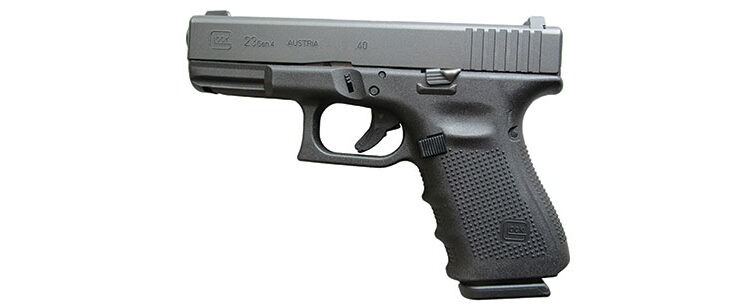By Aaron Brudenell
Introduction: Serial Numbers
According to company literature, the first Glock pistols imported into the U.S. came in January of 1986. These guns had serial numbers beginning with a two letter alpha prefix of “AF” followed by a three digit number. This means for every two letter combination, there were up to 1,000 pistols produced with numbers from 000 to 999. As of this writing, current new production Glock pistols bear serial numbers with a four letter and three number combination, a testament to the brand’s success and longevity over the past quarter century.
Most firearm manufactures who employ sequential serial numbering systems would not guarantee the sequence of numbers exactly matches production order but on the longer time frame they generally follow that trend. That is to say, a firearm bearing the serial number ABC001 may not have been completed prior to the same model numbered ABD001 but it’s a fair assumption that they were made around the same time and that EFG001 came later. Notable exceptions to the standard serial number structure are firearms ordered with specified serial number ranges and formats for law enforcement agencies and commemorative models.
Using this assumption as a framework, this article will seek to identify changes in individual Glock cosmetic and design features and identify their sequence in the model history. While a strict serial number sequence is an inexact assumption, an accurate time line of importation for serialized firearms can be dated through records available from Glock.
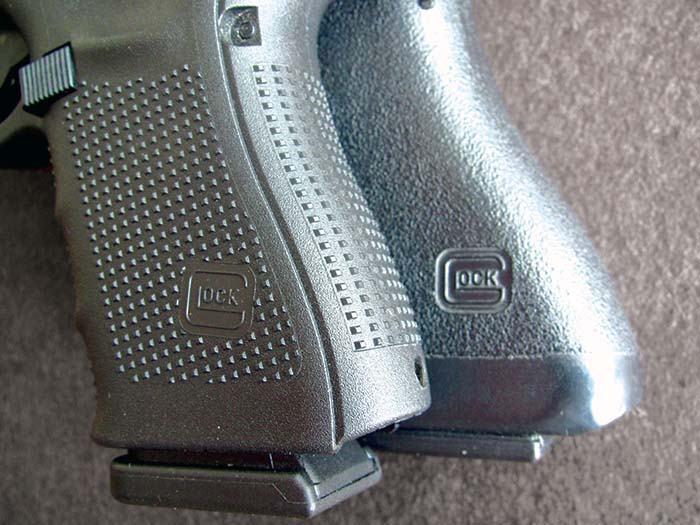
Overview of Glock Generations, Terminology and Associated Models
Because of the nature of the firearms manufacturing industry, terminology can be inexact due to the influence of non-anticipated design changes, marketing language, and customer terminology not originating from the manufacturer. In some cases, this post production vernacular sets the standard for terminology in use by most. This stands to reason given that the number of people buying, using, and writing about the firearms far out numbers those within the company that might otherwise like to control the terminology. This is how distinct Glock generations came to be understood.
Glock pistols are categorized into four distinct generations (with a 4th ultimately being officially acknowledged by the gun’s markings). The first generation guns had a relatively uniform grip texture around the entire handle of the frame behind and below the trigger guard and consisted of the original Glock model 17 and a few scarce early model 19 pistols. The second generation guns had rectangular checkering on the front and back grip surfaces and can safely be counted on to include the models 17 through at least 24.
Third generation guns are described as those with finger grooves superimposed on the front strap checkering and an accessory rail forward of the trigger guard on models large enough to incorporate this feature. The addition of a slight “thumb rest” at the upper edge of the grip is also among these third generation features and this particular feature relates to U.S. importation criteria.

Finally, 4th generation Glock models incorporated rectangular checkering throughout the grip surface, a smaller grip with back strap extensions, a reversible magazine release, and the slide/recoil spring assembly was updated to include a dual spring for all models. The new slide and guide rod assemblies are not back-compatible with earlier models.
While these categories are useful, the details in some cases can muddy the waters. Several models of Glock firearms were made bearing the 3rd generation finger grooves but no associated accessory rail. Guns of this type are rare and typically described as transitional or “Generation 2.5.” For the collector or firearm examiner wishing to evaluate this firearm, it’s safe to say that guns of this type were produced in relatively low numbers and for a short period of time. The early versions of the subcompact Glock 26 and 27 pistols (9mm and .40 S&W) produced around the same time had finger grooves on the front strap of the pistol that were devoid of checkering that eventually appeared on later 3rd generation versions of those models. The slightly larger subcompact models 29 and 30 (10mm and .45 ACP) were always made with the checkered finger grooves but eventually produced with the previously omitted accessory rail. The earlier non-railed versions of the Glock 29 and 30 frames were made for a longer period of time than the early smooth finger grooved versions of the model 26 and 27 frames.
All models produced during the various generations were made consistently with the features of that generation. For that reason, early models like the Glock 17 will have versions from each of those generations. The Glock model numbers appeared sequentially although some models like the select fire 18 and the .380 models (25 and 28) are less common due to NFA and import restrictions.
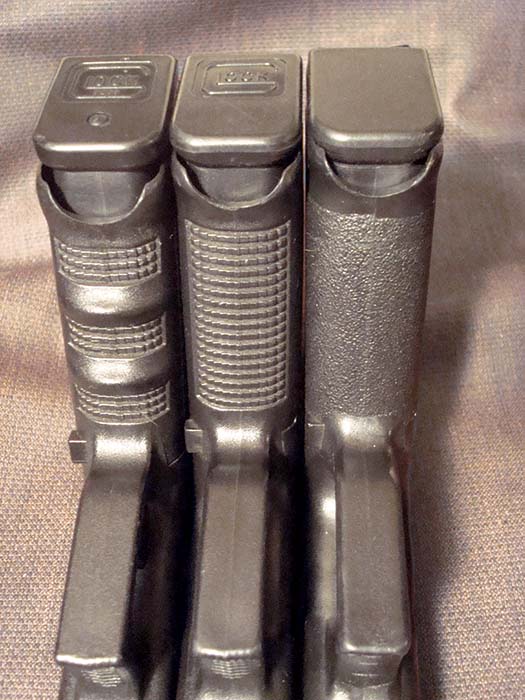
Generation 1 Glock Features
The Generation 1 guns are an exclusive club consisting of only the model Glock 17 and a very few of the earliest model Glock 19 pistols. (The Glock 18 is the select fire version of the model 17 and while 1st generation versions exist, because of their rarity and distinct internal geometry they won’t be discussed in this article.) A long-slide version of the 17 known as the 17L was also produced using 1st generation frames but the slides are interchangeable and the frames are indistinguishable with other model 17s. These will be described hereafter as belonging to the standard frame size designed for pistols chambered in 9mm Luger, .357 SIG, .40 S&W, .380 ACP, and eventually the .45 GAP (wide frame guns came later). The model 17 is categorized as a full sized pistol while the 19 is considered to be a compact in size. Both models were almost exclusively chambered for 9mm Luger although a few special exceptions have been known to exist (e.g.-9x21mm in Europe).
The first Glock pistols imported into the U.S. came with serial numbers beginning with two letters followed by the typical three numbers and a “US” suffix indicating they were for export to the United States. The two characteristic proof mark logos appeared on the frames, slides, and barrels while additional markings, such as a three letter manufacturer’s code and a pentagon appeared on the barrel only.
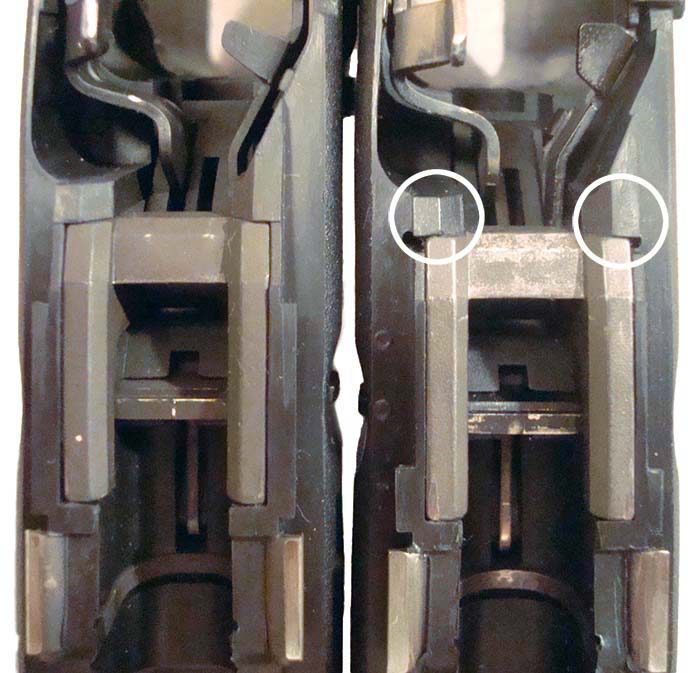
The official serial number in the United States is the one appearing on the frame which includes the “US” suffix. These numbers appear on a metal insert on the bottom of the frame just ahead of the trigger guard. The early versions of these were black in color and the “US” appears to be in a different font than the alpha-numeric characters that make up the rest of the numbers. These black serial number plates were used in the early Generation 2 Glock 19 pistols in the same serial number ranges as their Generation 1 Glock 17 siblings.
Glock pistols have always had two cartouches on the top and bottom of the right side of the grip. The upper cartouche on the generation 1 pistols reads: “GLOCK, INC., SMYRNA, GA.” while the lower marking read “US. Pat. 4,539, 889”. Each of these is a single line of text that appears with embossed characters over a smooth background surface in the polymer of the frame surrounded by the existing texture.
The model 19 had another feature change from the 17 to add points towards those required for importation into the U.S. The otherwise smooth trigger of the model 17 was replaced with a serrated version. All Glock pistols the size of the model 19 or smaller were fitted with serrated triggers for importation, although it’s not uncommon for their owners to prefer the smoother trigger and retrofit the parts since they are interchangeable. Another key difference between the models 17 and 19 is the geometry of the barrel lug and matching locking piece inside the frame. They are positioned differently which is why barrels are not interchangeable between the full sized and compact frames. This distinction remains in subsequent generations and models/calibers.
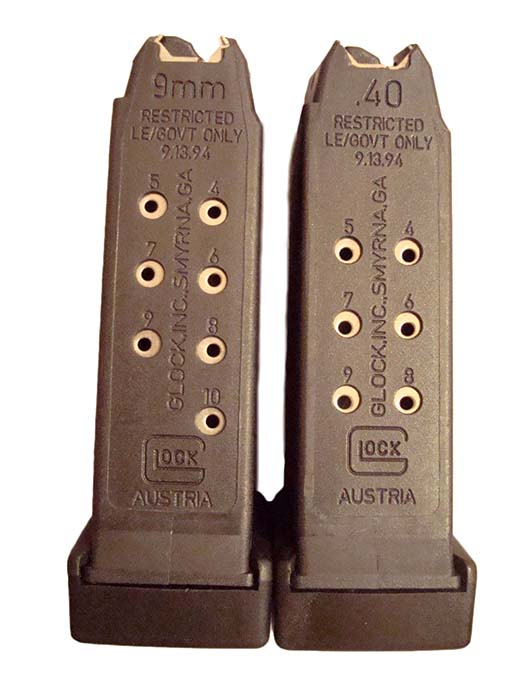
Generation 2 Glock Features
Because the Glock 17 preceded the Glock 19, there was initially no need to distinguish the two frames by markings. In fact, the very first Glock 19 pistols (1st generation) were actually made from Glock 17 frames that were trimmed to accommodate the smaller slide and magazine. An apparent mold mark on the left front corner of the trigger guard was eventually used for a marking location indicating which frame was being produced. This subsequent mold mark consists of a circular cartouche with the number 17 or 19 depending on the frame (earlier model 17’s had no such mark).
As has been described above, the main change that constitutes the generation 2 models is the retexturing of the grip surface. This rectangular pattern grip checkering on the front and back of the grip is often referred to as “grenade” checkering. Early generation 2 pistols were model 17’s and 19’s that retained the two single line grip cartouches on the right side, the 17/19 mold marks on the left, and Austrian proof marks of the generation 1 models, but not all had the silver colored serial number insert plate.
Around 1990 and about half-way through the two-letter serial number ranges, Glock started importing the models 20 (10mm), 21 (.45 ACP), 22, and 23 (both .40 S&W). By this time, the Austrian proof marks and the 17/19 mold mark were no longer present. The models 22 and 23 are essentially the .40 S&W versions of the 17 and 19 respectively; however, the more powerful cartridge forced a design change that added an additional pin to retain the locking piece in the frame. Some rare and early versions of these pistols may not have had the additional (3rd) pin. The models 20 and 21 were the first of the wide frame sizes made to accommodate the 10mm Auto and .45 ACP cartridges, respectively. All of these models are 2nd generation or later with both locking block pins in their design.
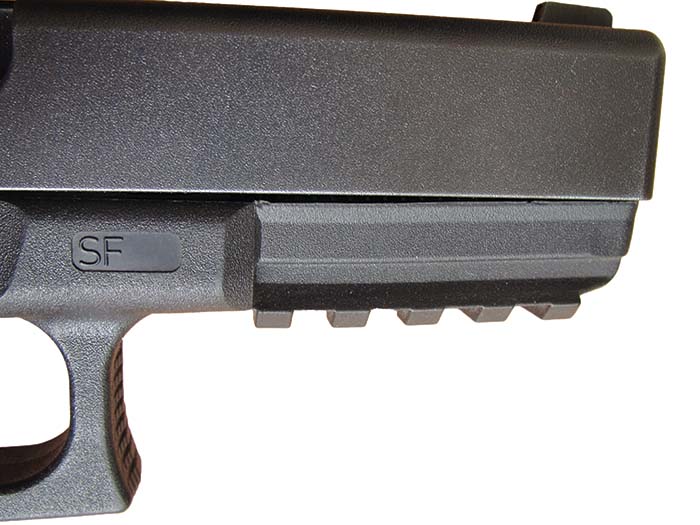
Prior to reaching the end of the two-letter serial number ranges, a second line was added to the upper cartouche on the grip of the pistol which now read:
MADE IN AUSTRIA
GLOCK, INC., SMYRNA, GA.
Right around the time of the roll over from two-letter serial numbers to three-letter series, the internal parts of the pistol changed from being mostly black in color to silver. This feature is not always a reliable one to consider because older guns receiving factory or armorer upgrades often have newer silver colored parts including some early upgrades to pre-EH### pistols that required an enhanced trigger bar that would increase the sear/striker engagement. These improved early trigger bars had a “+” stamped on the top rear portion near the area of striker engagement. While this upgraded trigger bar had a distinct shape, this author has seen at least one example of an earlier shaped part that has a bronze/gold color.
Shortly after the change from two-letter to three-letter serial numbers, a second line was added to the lower cartouche on the grip with two additional patent numbers. The next internal upgrade in this approximate chronology was angled cuts made to the interior of the frame to relieve the back two corners where the locking piece sits. Without this modification, those two corners were prone to the initiation of vertical cracks in the polymer due to the repeated impact of the corners of the metal locking piece to the frame. The relief cuts seemed to prevent the occurrence and could also be added to older models after the cracks had begun (essentially removing the cracks in the process of making the cuts at their location).
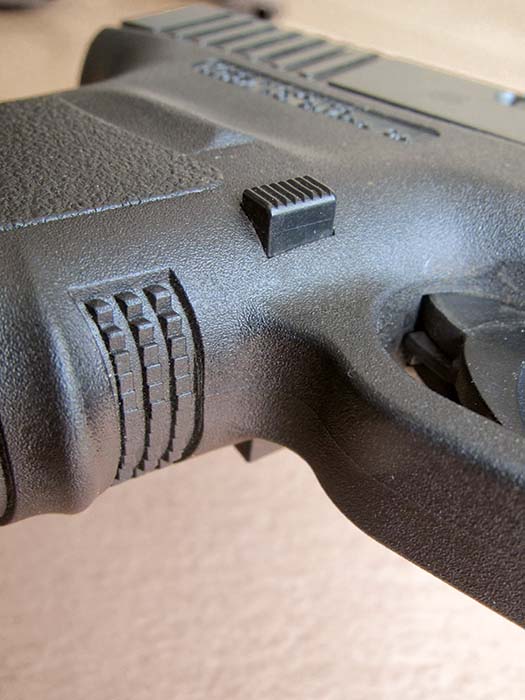
As with other internal upgrades, because these were often done by the factory after production, their presence tells less about the age of the pistol than their absence. Hypothetically, were the people at Glock, Inc. to discover an old batch of early generation 2 serialized frames; they would surely complete these upgrades before assembling them into pistols to be sold as new. Likewise, pistols returned to the factory as trade-in towards new models might also have similar upgrades.
The list of generation 2 changes above can be described sequentially based on the assumption of the serial numbers being sequential although this may not strictly be true. A more accurate description would be to say the changes listed here occurred during a watershed period during the middle of the second generation. The change from black internal parts to silver upgrade parts, the locking piece relief cuts, and the addition of a second line of text of the lower cartouche are all relatively contemporary changes roughly coinciding with the change from the two-letter to three-letter serial number range. Also in this time frame, the spring and guide rod assembly was upgraded to a one piece unit.
A few years later, in 1994, Glock began importing the model 24, which is essentially the 2nd generation equivalent of the 17L described earlier chambered in .40 S&W. With the exception of custom marked guns, all model 24’s and all subsequent model numbers have at least three letters in the serial number range. Some time later the angle of the right rear surface of the ejection port was changed from a 90 degree angle to something slightly larger. This change occurred between the introduction of the model 24 and the subcompact models 26 and 27 in 9mm and .40 S&W respectively. What this means is that one may encounter a model 24 with the earlier 90 degree ejection port angle but all models 26 and later had the newer geometry.
The early model 26 and 27 pistols were the first to incorporate finger grooves in the front strap of the grip; however, these were not checkered like those that came before and after. It may be easiest to regard the models 26-28 with the smooth front strap as generation 2 because they are like the proto type for the generation 3 changes and appeared prior to the addition of the accessory rail that fully defines generation 3 guns. These first subcompact pistols incorporated the “thumb rest” feature at the top of the grip so they could be legally imported into the U.S. market. On the other hand, the large frame subcompact pistols, models 29 and 30 (chambered in 10mm Auto and .45 ACP respectively) were always produced with checkered finger grooves on the front strap and their ultimate upgrade to having an accessory rail occurred much later so it may be best to classify all of these in generation 3.
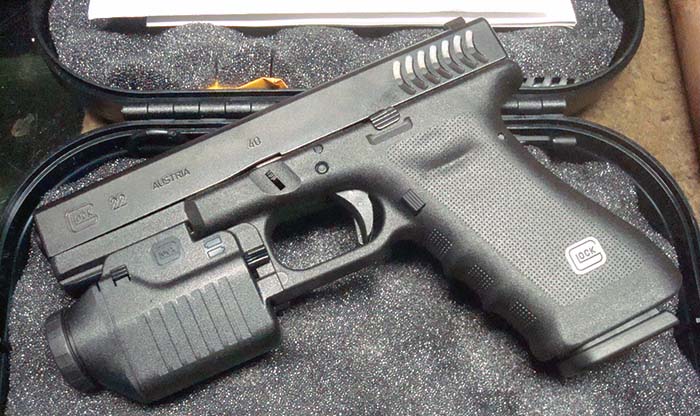
Generation 3 Glock Features
Generation 3 Glocks incorporated all of the feature changes listed above and changed very little in the years to come. A few early models of the .357 SIG pistols were made with finger grooves and no accessory rail (a.k.a. “generation 2.5”) but these can be considered rare. Additional models added after the switch to generation 3 included the 29 (10mm), 30 (.45 ACP), 31-33 (.357 SIG), 34 (9mm), 35 (.40 S&W), and the slim frame model 36 which was unique in that it was a .45 ACP pistol with the slide dimensions of the 9mm and a single stack frame that was even thinner! The models 37-39 were later introduced in the .45 GAP cartridge. These guns used the standard 9mm sized frame with a wider slide similar to the 10mm/.45 ACP models.
Towards the later years of the 3rd generation, some special versions of existing models were introduced along side the standard models. Versions of several models described as having a Rich Texture Finish (RTF) were made that incorporated a distinct texture on all surfaces of the grip and cosmetically unique slide serrations. These were not commercially successful and subsequently produced in smaller numbers.
Some of the larger 10mm/.45 ACP models were made with “Short Frames” (SF) that had a grip back strap/palm swell that was reduced in size. These models arrived around the same time as the addition of the accessory rail on the subcompact versions (29/30) and were marked on the right side of the frame above the trigger guard with a short cartouche bearing an “SF” embossed on the smooth polymer.
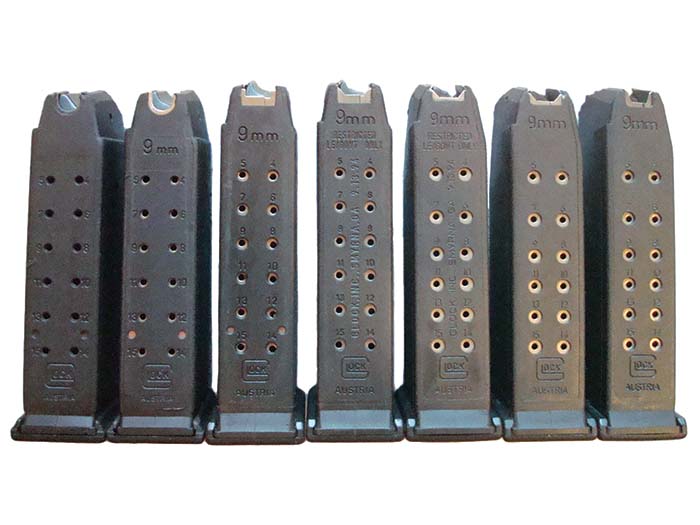
One smaller subset of these models is the Glock 21 SF with the larger 1913 rail built into the frame instead of the usual single notch accessory rail. These were made in anticipation of design features requested for a new U.S. Army service pistol competition. This particular model was made with a new ambidextrous magazine release that was very different from the previous designs. This system captured the magazine with a thin paddle on the forward interior of the magazine well and would not function with older magazine designs. For this reason, all subsequent magazines were made with this additional forward cutout, although the military competition never happened and these design features have not been repeated on subsequent models.
Around the time of the SF models, the serial numbers on Glock frames dropped the “US” suffix and all slide, frame, and barrel numbers were identical. This occurred before the arrival of the 4th generation designs or the U.S. made Glock pistols that appear to all use the longer four letter plus three number serial number structure. At present, both 3rd and 4th generation pistols are being made in the U.S. and Austria. The only technical difference between the two seems to be in the metal finish – the Tennifer process used in Austria has been replaced by a Melonite process for U.S. made handguns. It remains to be seen if this difference will distinguish the two products in the open market.
| This article first appeared in Small Arms Review V18N6 (December 2014) |



